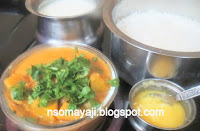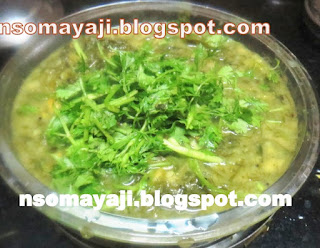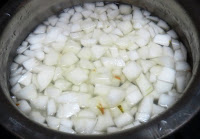Pumpkin spicy curry is a side dish and easy to prepare. You can have this side dish with almost all the main dishes.
I have used pumpkin, coconut and home prepared spice powder.
Let us see some benefits of eating pumpkin in our diet.
Pumpkin is filled with vitamins and minerals. It has potassium and anti oxidant properties. It has Vitamin A Vitamin C and Vitamin E. Pumpkin is very low in calorie and it keeps you full for a longer time. It is good for weight loss. It is full of fiber. It ia good for our eye health. Eating pumpkin is good for our immunity health. It helps in fighting against bacterial infections and fungal infections. Beta carotene in pumpkin helps to protect our skin. It also helps in reducing the glucose level and increasing the amount of insulin in our body. It is good for diabetes.
No onion or No garlic is used in this Pumpkin Spicy Curry.
I have not used any dal in this curry. Udupi style Pumpkin Spicy Curry. It is easy, simple and quick.
Pumpkin Pieces : 1 Big bowl
To Add :
Salt : As required
Turmeric powder : A pinch
Tamarind pulp : 1 Teaspoon
Methi/Fenugrik seeds : 1/4 Teaspoon
To Grind :
Sambar Powder/Rasam powder : 2 Teaspoons
Coconut : 3 to 4 Tablespoons
To Season :
Coconut oil : 1Tablespoon
Mustard seeds : 1/2 Teaspoon
Jeera : 1/2 Teaspoon
Ingh/Asafoetida : A pinch
Curry Leaves : 6 to 8
Green chilly :1
2. Grate coconut and grind it with sambar/rasam powder using little water.
3. Keep a pan on the fire and heat. Add coconut oil, mustard seeds, jeera and let it fry.
4. Let mustard seeds splutter. Add ingh, green chilly and curry leaves.
5. Add pumpkin pieces and stir once. Add 1/2 cup of water, a pinch of turmeric and cook on medium flame till they turn slightly soft.
6. Soak tamarind in hot water for 5 minutes and squeeze out the pulp. Add it to cooked pumpkin pieces. Add methi seeds. (Raw methi seeds).
7. Add required salt and mix it well. Add ground coconut mixture and mix it slowly. Add 1/2 cup of water if required. Let Pumpkin Spicy Curry boil for 2 to 3 minutes.
8. Shift the curry to a serving bowl and serve with hot rice.
Time : 20 Minutes.
Serves : 3 to 4
Style : South Canara /Udupi/Karntaka/India.
Dry grind it once it is cools.
( 1 time use).
I have used pumpkin, coconut and home prepared spice powder.
Let us see some benefits of eating pumpkin in our diet.
Pumpkin is filled with vitamins and minerals. It has potassium and anti oxidant properties. It has Vitamin A Vitamin C and Vitamin E. Pumpkin is very low in calorie and it keeps you full for a longer time. It is good for weight loss. It is full of fiber. It ia good for our eye health. Eating pumpkin is good for our immunity health. It helps in fighting against bacterial infections and fungal infections. Beta carotene in pumpkin helps to protect our skin. It also helps in reducing the glucose level and increasing the amount of insulin in our body. It is good for diabetes.
No onion or No garlic is used in this Pumpkin Spicy Curry.
I have not used any dal in this curry. Udupi style Pumpkin Spicy Curry. It is easy, simple and quick.
Things Needed :
To Cook :Pumpkin Pieces : 1 Big bowl
To Add :
Salt : As required
Turmeric powder : A pinch
Tamarind pulp : 1 Teaspoon
Methi/Fenugrik seeds : 1/4 Teaspoon
To Grind :
Sambar Powder/Rasam powder : 2 Teaspoons
Coconut : 3 to 4 Tablespoons
To Season :
Coconut oil : 1Tablespoon
Mustard seeds : 1/2 Teaspoon
Jeera : 1/2 Teaspoon
Ingh/Asafoetida : A pinch
Curry Leaves : 6 to 8
Green chilly :1
Method :
1. Wash and remove the outer layer (Peel off the skin) and cut into small pieces. Wash the pieces and keep it aside.2. Grate coconut and grind it with sambar/rasam powder using little water.
3. Keep a pan on the fire and heat. Add coconut oil, mustard seeds, jeera and let it fry.
4. Let mustard seeds splutter. Add ingh, green chilly and curry leaves.
5. Add pumpkin pieces and stir once. Add 1/2 cup of water, a pinch of turmeric and cook on medium flame till they turn slightly soft.
6. Soak tamarind in hot water for 5 minutes and squeeze out the pulp. Add it to cooked pumpkin pieces. Add methi seeds. (Raw methi seeds).
7. Add required salt and mix it well. Add ground coconut mixture and mix it slowly. Add 1/2 cup of water if required. Let Pumpkin Spicy Curry boil for 2 to 3 minutes.
8. Shift the curry to a serving bowl and serve with hot rice.
Note :
Do not over cook the pumpkin pieces. It cooks faster and turns as paste. Use of any sambar/rasam powder is optional. I have used home prepared sambar powder. It taste better. Use of any dal is optional. Do not add much tamarind. It should be mild. Adding methi/Fenugrik seeds helps to lower the cholesterol level in the curry. It helps to digest the food easily. Do not add more water to the curry. It should be bit thick. (Taste better).Time : 20 Minutes.
Serves : 3 to 4
Style : South Canara /Udupi/Karntaka/India.
Home made Sambar Powder :
Dry roast 1/4 Teaspoon of methi seeds, 1/2 teaspoon of channa seeds/Kadale bele, 2 tablespoons of coriander seeds and 1/2 Teaspoon of jeera/cumin seeds with 5 to 6 byadagi chilly.Dry grind it once it is cools.






















































